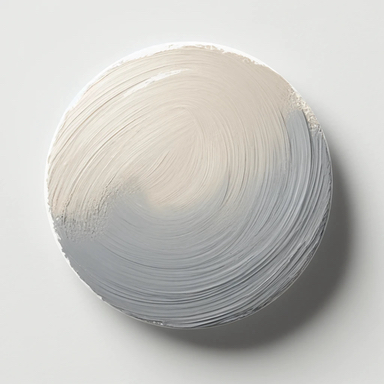Elephant's Breath
05/10/24 11:22 AM
[updated 3 November 2024]
I read this passage in Viv Albertine's "Clothes3. Music3. Boys3":
I had never heard of "elephant's breath" before. It's a paint color from the British manufacturer Farrow and Ball. This site says that the RGB values for Elephant's Breath are 204, 191, 179. ChatGPT says that the RGB values are 187, 173, 160.
I read this passage in Viv Albertine's "Clothes3. Music3. Boys3":
Each morning I start again with the questions, easy stuff, like colour – I’ve always been drawn to colour. Mum made colour interesting for me, when I was little; she would say, ‘See the colour of that woman’s skirt? That’s called elephant’s breath.’ Or, ‘See that ribbon? It’s mint green...
I had never heard of "elephant's breath" before. It's a paint color from the British manufacturer Farrow and Ball. This site says that the RGB values for Elephant's Breath are 204, 191, 179. ChatGPT says that the RGB values are 187, 173, 160.
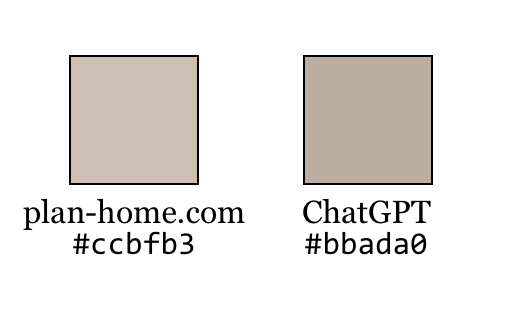
ChatGPT draws it as:
Comments
Solid State Jabberwocky
06/27/22 11:31 AM
This take on Lewis Carroll's Jabberwocky is from the April, 1972 edition of Datamation magazine.
The only reference to this on the web that I can find is at archive.org. This poem is 50 years old. I wonder who else, besides me, remembers it?
'Twas Burroughs, and the ILLIACS
Did JOSS and SYSGEN in the stack;
All ANSI were the acronyms,
and the Eckert-Mauchly ENIAC.
"Beware the deadly OS, son!
The Megabyte, the JCL!
Beware the Gigabit, and shun
The ponderous CODASYL!"
He took his KSR in hand:
Long time the Armonk foe he sought.
So rested he by the Syntax Tree
And APL'd in thought.
And as in on-line thought he stood,
the CODASYL of verbose fame,
Came parsing through the Chomsky wood,
And COBOL'ed as it came!
One, two! One, two! And through and through
The final pol at last drew NAK!
He left it dead, and with its head
He iterated back.
And hast thou downed old Ma Bell?
Come to my arms, my real-time boy!
Oh, Hollerith day! Array! Array!
He macroed in his joy.
'Twas Burroughs, and the ILLIACS
Did JOSS and SYSGEN in the stack;
All ANSI were the acronyms,
and the Eckert-Mauchly ENIAC.
-- William J. Wilson
The only reference to this on the web that I can find is at archive.org. This poem is 50 years old. I wonder who else, besides me, remembers it?
"Stirring the emerald green"
07/22/16 02:00 PM
[Updated 05/10/2024]
 In surprise, but as slowly as in regret, she stopped stirring the emerald green. She got up from where she had been squatting in the middle of the floor and stepped over the dishes which were set up on the matting rug. She went quietly to her south window, where she lifted a curtain, spotting it with her wet fingers.
In surprise, but as slowly as in regret, she stopped stirring the emerald green. She got up from where she had been squatting in the middle of the floor and stepped over the dishes which were set up on the matting rug. She went quietly to her south window, where she lifted a curtain, spotting it with her wet fingers.
For some reason, I was entranced by the phrase "stirring the emerald green." It's a beautiful combination of words. But what could it possibly mean? There was nothing in the text up to that point that hinted at what she might have been doing.
She banged her hands on her hipbones, enough to hurt, flung around, and went back to her own business. On one bare foot with the other crossed over it, she stood gazing down at the pots and dishes in which she had enough color stirred up to make a sunburst design. She was shut up in here to tie-and-die a scarf. [pg. 34, 36]
Now it all makes sense!
I found this book at Riverby Books in Fredericksburg, VA and bought it on a whim because Welty lived near Belhaven University, where my daughter went to school. Welty's style is reminiscent of Ray Bradbury and Bradbury notes her influence on his writing.
Read More...

For some reason, I was entranced by the phrase "stirring the emerald green." It's a beautiful combination of words. But what could it possibly mean? There was nothing in the text up to that point that hinted at what she might have been doing.
She banged her hands on her hipbones, enough to hurt, flung around, and went back to her own business. On one bare foot with the other crossed over it, she stood gazing down at the pots and dishes in which she had enough color stirred up to make a sunburst design. She was shut up in here to tie-and-die a scarf. [pg. 34, 36]
Now it all makes sense!
I found this book at Riverby Books in Fredericksburg, VA and bought it on a whim because Welty lived near Belhaven University, where my daughter went to school. Welty's style is reminiscent of Ray Bradbury and Bradbury notes her influence on his writing.
Read More...
Gems from John R. Pierce
02/08/13 07:39 PM
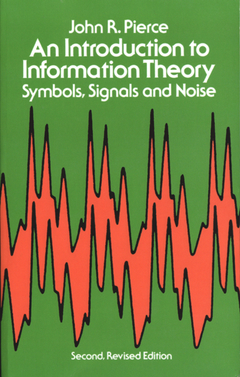
"Mathematically, white Gaussian noise, which contains all frequencies equally, is the epitome of the various and unexpected. It is the least predictable, the most original of sounds. To a human being, however, all white Gaussian noise sounds alike. It's subtleties are hidden from him, and he says that it is dull and monotonous. If a human being finds monotonous that which is mathematically most various and unpredictable, what does he find fresh and interesting? To be able to call a thing new, he must be able to distinguish it from that which is old. To be distinguishable, sounds must be to a degree familiar. … We can be surprised repeatedly only by contrast with that which is familiar, not by chaos." [pg. 251, 267]
112°F
06/30/12 04:51 PM
My car's thermometer registered 112°F around 4:15pm.
Oh it's no feat to beat the heat.
All reet! All reet!
So jeet your seat
Be fleet be fleet
Cool and discreet
Honey...
With fond memories of Alfred Bester.
Oh it's no feat to beat the heat.
All reet! All reet!
So jeet your seat
Be fleet be fleet
Cool and discreet
Honey...
With fond memories of Alfred Bester.
Cubism
11/04/11 10:23 PM
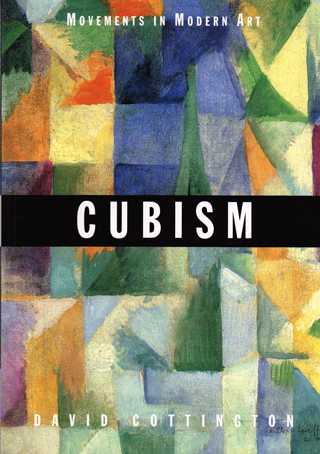
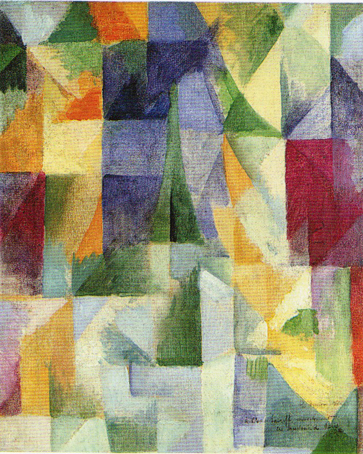
Dispensing with the screen of neo-Impressionist brushstrokes - perhaps recognizing its superfluity, given the constructive potential of the device of a colour grid - Delaunay orchestrates a range of spectral colors around the spatial recession from the foreground orange curtains to the background blue sky and the green profile of the tower. As in the hermetic paintings of Picasso and Braque, the representational legibility of the image is secured by the vestigial iconic character of these motifs. But unlike their exploration and celebration of the linguistic magic of painting for its own sake - or perhaps for its suggestion of a reality beyond appearance - Delaunay's bracketing of his complex and fragmented representation of the cityscape between the external limit of the picture frame/window and the internal limit of the distant tower posits an equivalence between the experience of deciphering the painting and the active, constructive nature of visual perception that life in a modern city entails. [pg 61].
"Vestigial iconic character?" The pointed green triangle-like object is the Eiffel Tower? The blue is the sky? The yellow-orange represents curtains? There's a cityscape in there somewhere? Obviously I am a barbarian, unlearned in the vocabulary of Cubism. Nevertheless, some Cubist art is strikingly beautiful. Even if I don't necessarily know what it means.
Proud Father, II
12/08/09 11:05 PM
La Belle Heaulmiere
11/07/09 08:46 PM
My wife sent me this cartoon with the comment, "This may be me in the not-to-distant future."

At the same time, I was re-reading Heinlein's Stranger In A Strange Land (yes, the 1975 Berkeley edition. My hardback copy of the uncut version is on loan) and came across Jubal's description of Rodin's "La Belle Heaulmière":
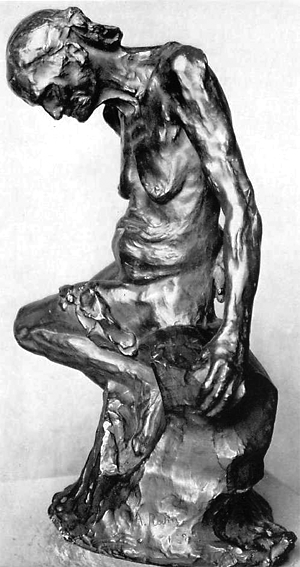 Anybody can see a pretty girl. An artist can look at a pretty girl and see the old woman she will become. A better artist can look at an old woman and see the pretty girl she used to be. A great artist can look at an old woman, portray her exactly as she is...and force the viewer to see the pretty girl she used to be...more than that, he can make anyone with the sensitivity of an armadillo see that this lovely young girl is still alive, prisoned inside her ruined body. He can make you feel the quiet, endless tragedy that there was never a girl born who ever grew older than eighteen in her heart...no matter what the merciless hours have done.
Anybody can see a pretty girl. An artist can look at a pretty girl and see the old woman she will become. A better artist can look at an old woman and see the pretty girl she used to be. A great artist can look at an old woman, portray her exactly as she is...and force the viewer to see the pretty girl she used to be...more than that, he can make anyone with the sensitivity of an armadillo see that this lovely young girl is still alive, prisoned inside her ruined body. He can make you feel the quiet, endless tragedy that there was never a girl born who ever grew older than eighteen in her heart...no matter what the merciless hours have done.
My darling wife: your beauty will never fade.

At the same time, I was re-reading Heinlein's Stranger In A Strange Land (yes, the 1975 Berkeley edition. My hardback copy of the uncut version is on loan) and came across Jubal's description of Rodin's "La Belle Heaulmière":

My darling wife: your beauty will never fade.


